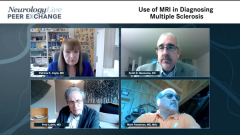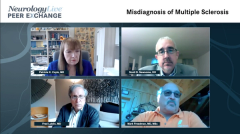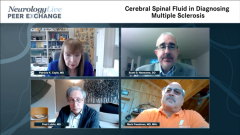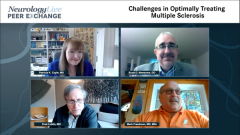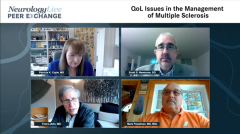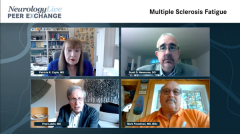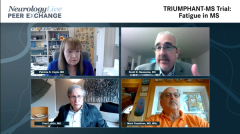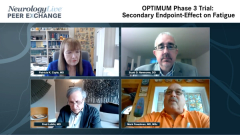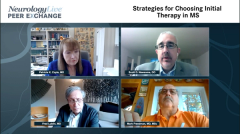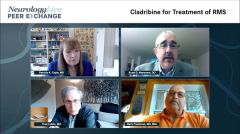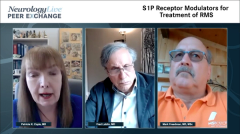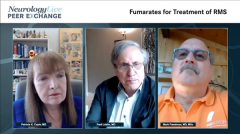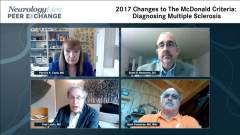
Misdiagnosis of Multiple Sclerosis
Episodes in this series

The panel members discuss their clinical work-up criteria, including the use of cerebral spinal fluid, to make a more accurate multiple sclerosis diagnosis.
Fred Lublin, MD: Mark, why don’t you tell us a bit about the issue of misdiagnosis and our concerns?
Mark Freedman, MD, MSc: This was, as you said, a huge question that came up repeatedly, and we had to emphasize the point that the diagnostic criteria were being driven by accuracy. That means we’re not willing to sacrifice specificity for sensitivity. We could easily have made sensitivity 100%. The last thing you want to do is put an MS [multiple sclerosis] label on someone when it doesn’t belong. That usually leads to treatments that are not going to work and delay in the appropriate diagnosis and most appropriate therapy.
We erred on the side of specificity, knowing full well that there are some patients who probably have MS but may not meet the McDonald criteria. They’re going to be close. The advice is, if they haven’t met the criteria, they probably will. That means improved vigilance, repeated testing, maybe repeating the LP [lumbar puncture], and repeating even the MRIs at an earlier date than expected to show that the activity is consistent with multiple sclerosis. We do not want to miss another entity.
We’re gaining a lot of information on some of those other entities, such as NMO [neuromyelitis optica], MOG antibody demyelination, and some of the other differentiating imitators that are treated different from multiple sclerosis. In fact, some of the drugs that we use to treat MS might make these other conditions like NMO worse.
That’s the driving force for the new version of the McDonald criteria.
Fred Lublin, MD: Excellent. Pat, do you have any other thoughts about the issues of misdiagnosis, sensitivity, and such?
Patricia K. Coyle, MD: Misdiagnosis is a big deal, and we recognize that it’s a real problem, so there’s a responsibility to create a differential diagnosis and do a work-up. It argues for a vigorous work-up. We don’t have a diagnostic biomarker. There should be selected bloodwork. I’m personally for everyone with possible relapsing MS sending aquaporin 4 and MOG IgG in the blood to rule that out. We image the brain and the spinal cord. We do a lumbar puncture and look at CSF [cerebrospinal fluid] in virtually everyone, and we’re doing OCT [optical coherence tomography]. I believe in a robust evaluation to be as certain as possible that you have an accurate diagnosis.
Fred Lublin, MD: There’s no question about that. The OCT and MRI assist you, as well, in following patients over time, whereas the spinal cord is a onetime event. I agree with you. Since 2017, you’ve been a big proponent of spinal fluid analysis, as has Mark. I must say that since 2017, we’re using it more.
Patricia K. Coyle, MD: Fred, I’d like people to start using the 2017 diagnostic criteria here in the United States and stating in the chart whether the patients meet the criteria. I would like to see neuroradiology use them as well. We aren’t doing enough with that.
Scott D. Newsome, DO: I agree. Some of the studies that Andy Solomon has put out show that even in MS centers, misdiagnosis rates are as high as 10%. That is not insignificant. As Mark has mentioned, it could have catastrophic effects if you put someone on a therapy that unmasks NMO or MOG antibody demyelination and makes the disease worse.
I hope people will start to use the 2017 criteria vigilantly. It’s for our patients. Fred, I’m similar to you in that earlier in my career, I probably wasn’t doing as many lumbar punctures. But now I’m convinced that it adds value in making the diagnosis. It may even have some prognostic value in predicting what may be to come in the future for a patient. That is based on multiple studies showing that there may be an increased relapse rate and more disability long term if you have oligoclonal bands.
One last point is that oligoclonal bands are typically not seen in the context of NMO and anti-MOG. If you have a clinical syndrome and you’re on the fence about whether it is MS or 1 of these imitators, if you have oligoclonal bands present, that does sway me more toward MS vs those other conditions. Then you throw in an OCT. If you see some temporal thinning, that can help.
Mark Freedman, MD, MSc: Not to belabor the point about CSF, but I’d still like to put a plug in anyway for a couple of reasons. I agree with everything that Pat and Scott have said, but the true value of spinal fluid in the context of diagnosing MS—and this is where these ancillary tests play a big role—is that not everyone presents with a clear-cut demyelinating event. They may have a history that’s unclear and you don’t have objective data. The MRI indicates that maybe it is MS, but maybe it isn’t. It could be an older individual who is a smoker and has migraine or something that creates some of these deep white-matter lesions. Maybe the central vein sinus is there. It’s giving you an indication of something else. It’s the “what else could it be,” and that’s where the CSF plays a role. If you see a high cell count, that’s a red flag.
You’re looking for a reason to say it’s not MS. The CSF is very powerful there. The other important feature is, if someone comes in with a long history of fatigue and some nebulous symptoms and someone in the past has done an MRI, you may not get your hands on it. They may have called it MS. If they’ve had so-called established MS for years and the CSF is negative by the standardized tests, the negative predictive value of CSF is very high. If it’s a negative test result, that’s a red flag in someone who supposedly has established disease.
Fred Lublin, MD: I agree with you, Mark. If you were doing the spinal fluid analysis, then it’s sent out by the lab, probably to the lowest bidder. The number of CSF-negative people who we’re pretty certain have MS is considerably higher when we look at what’s done for a routine lab vs what’s done in a place that has an interest in CSF and does the studies.
Mark Freedman, MD, MSc: There’s an FDA-approved test.
Fred Lublin, MD: I understand, but those numbers just never add up to what we see from the people who have the research interest.
Newsletter
Keep your finger on the pulse of neurology—subscribe to NeurologyLive for expert interviews, new data, and breakthrough treatment updates.

